| Zeb Turner and Chunk Pacheco are “lined out” by community member Brian Mena as clean up continues of SR 124. |
The Iron Horse Preservation Society has brought the group’s rails to trails program to the unused, decaying track just south of Utah State Road 123 in East Carbon.
With city officials, the society will remove between nine to 12 miles old railway and turn it into usable ATV track with recreation amenities for tourists as well as residents.
According to East Carbon Mayor Orlando LaFontaine, the society has been moving track currently owned by the Intermountain Power Agency in order to construct a staging area for the Carbon County ATV trail and a general use riding area for campers and riders.
“We are looking at constructing 10 campsites with barbecue pits and a restroom in the area,” spointed out LaFontaine. “We want this to be a place where families can come and enjoy their ATVs. We also think it will help the county add another staging area to their ATV trail.”
The campsites will be constructed to the west of the track site just east of State Road 124. LaFontaine also hopes that the area will further East Carbon’s economic development.
“We are trying to clean up these existing buildings to use for recreational vehicle parking and event rental,” said LaFontaine. “The track is going to include jumps, race ways and a mud pit. We are hoping to have yearly events here.”
LaFontaine reported that the project is currently employing five part time workers from the area brought in for clean up.
“We couldn’t be happier with the way things are going,” said LaFontaine.
Iron Horse was founded in 2005 to preserve the nation’s railroad heritage and optimize the use of materials no longer in use, according to ironhorsepreservation.org.
“Our founders had observed many times where railroad track materials had been buried, destroyed or dumped instead of being put back to use in many possible ways,” states the site. “No longer used railroad corridors were left with track and allowed to become heavily overgrown and used as dumping locations. The opportunity to capture our history and educate the public on our railroading heritage was ignored. At Iron Horse we saw the opportunity to do something that would really make a difference so we put our experience and skill to work to address these problems.”
The society is almost entirely funded from residual proceeds procured from track removal operations.
According to the website, Iron Horse has removed more than 100 miles of track along all varieties of railroad corridors and environmental conditions.
With the demand for public recreation and exercise increasing, the rails to trails is becoming more popular.
“The rail trails are left smooth and firm for easy walking or running. Mountain bikes, ATVs and other vehicles could also access the corridor depending on your requirements,” states the society’s site. “Rail corridors provide a continuous path with few interruptions and at gentle grades.”
Iron Horse uses part of the left over track for national security purposes.
In 2007 the society was contacted to aid with some of the challenges facing Operation Jump Start.
“Illegal vehicles cross the border daily causing confrontations that can lead to unnecessary casualties,” states the site.
According to the officials, the society got on board immediately to face the problem by removing track and assembling it into star shaped vehicle barriers at no cost to the federal government.
The barriers are then strategically placed at the U.S. Mexican border.
Iron Horse has received several awards from the federal government for their assistance and is currently in planning with the department of justice to seek out more sites near the border in order to create more barriers.
As for local barriers, mayor LaFontaine would like to remind residents that the property is private and all trespassers will be prosecuted as such.
Only authorized personnel are allowed within the project area at this time.
“Our city officials and residents have worked hard to ensure the economic growth of this area and this project is another step in the right direction,” concluded LaFontaine.

